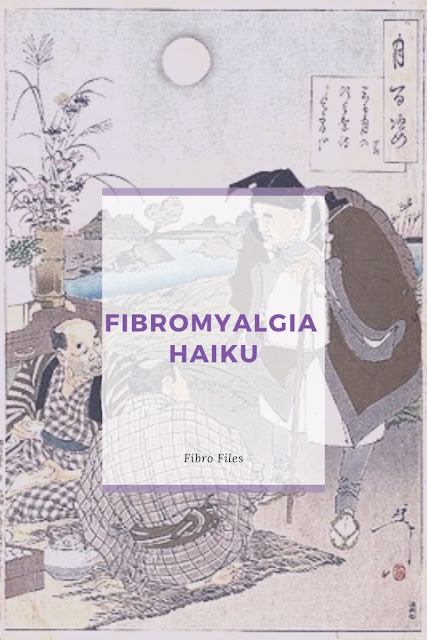This is my first attempt at a haiku in many years. I think we studied and wrote them in high school. They appealed to my seventeen-year-old self and now again they appeal to my older self - the part that lives in pain. I wrote this as April 17th is Haiku Poetry Day.The day is passing / The feathery bed is all/ That is left for me.
If there’s one thing that we remember from High School, it’s the day that we were introduced to the great Japanese art-form that is Haiku. While it may have an ancient and noble history, it is likely at it’s most ignoble when a group of young kids try to cobble together Haiku in series of five-seven-five. Haiku Day reminds us that there is so much more to this style of poetry than a misspent week in our literature courses! Days of the Year
I think the following haiku titled 'pain is your prison' by Peter Galen Massey describes Fibromyalgia well.
when the true pain comes / the body is your prison / and your enemy
What is Haiku?
The Haiku is a traditional form of Japanese poetry written in three lines.
The first and last lines of a Haiku have 5 syllables and the middle line has 7 syllables.
The lines rarely rhyme.
Haiku is a mood poem.
They began to appear as an independent poem, in Japan, by the time of Matsuo Bashō (1644–1694) who wrote many in his lifetime. Basho was the most famous poet of the Edo period in Japan. During his lifetime he was recognized for his poetry and today he is recognized as the greatest master of haiku.
So what should haiku accomplish? What should it provide the reader? According to the classic haiku poets of Japan, haiku should present the reader with an observation of a natural, commonplace event, in the simplest words, without verbal trickery. The effect of haiku is one of "sparseness". It's a momentary snatch from time's flow, crystallized and distilled. Nothing more. LITERARY KICKS
I hope you may try and write a haiku to express anything about your life. I also hope, like me that you enjoy trying to work within the limits of this ancient art form.
 |
| Bashō (master of haiku) meets two farmers celebrating the mid-autumn moon festival in a print from Yoshitoshi's Hundred Aspects of the Moon. |

I enjoyed this post
ReplyDeleteI learned about the Haiku
Thank you for sharing
oh, thanks so much Pamela.
DeleteYou have been nominated for the Inaugural Chronically Hopeful Award! Congratulations! Please see the details here: https://pamelajessen.com/other-thoughts/the-chronically-hopeful-award/
ReplyDeleteThank you for the nomination. I love the name - chronically hopeful.
DeleteLove you sharing your creative writing within a blog like this. I love writing poetry too. Its one of the forms of writing my brain can naturally create even when I'm foggy.
ReplyDeleteThanks so much Katie. So glad you can be creative even when feeling foggy... the creative brain finds ways.
Delete